Living and Working in Bangkok Transport / Getting Around
Getting Around
For a city of more than 10,000,000 people, a population that has mushroomed over the past 30 or so years, that growth has met with growing pains and getting around Bangkok can be challenging for the new resident. But there are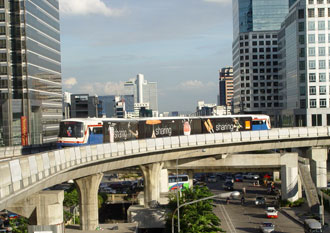 many transport options available and once you have an understanding of the different transport options available, it is not nearly as bad as it looks. Really!
many transport options available and once you have an understanding of the different transport options available, it is not nearly as bad as it looks. Really!
Let's start by saying that the nightmare stories you have heard about traffic in Bangkok are all absolutely true! The traffic in Bangkok is absolutely appalling. Living here you sort of get used to it but whenever I go away from Bangkok for a few days and then return, I wonder how the hell I live with it. Even outside of the peak times, a journey of 5 or 6 km can take an hour. At peak times, and especially when the weather is bad, particularly in the wet season, journeys by road can take a ridiculously long length of time. Basically, getting around by road is at times, an absolute nightmare. In the rainy season of '98, I can vividly remember waiting at the bus stop for more than an hour and the traffic just didn't move at all, and I was eventually forced to walk home! Some of the cars had even turned off their engines! In the end I just thought bugger it and walked home, getting absolutely drenched! A friend tells me a story of how we was driving home over the Rama 9 bridge and traffic stopped, for 4 hours! But perhaps the worst story of all, and a heartbreaking one in many ways concerns a former student of mine. She was a wonderful young woman, so keen to learn English and truly joy to teach. She had a morning class with me, one on one tuition from 9:00 AM. She never showed up for her morning class, which was very unusual. As I was waling out the door just after 4:00 PM, she arrived at the language school. The bus she was coming in on had got stuck in a traffic jam and she had been stuck in it, on the expressway, for over 6 hours! The poor girl was heartbroken that she had missed her lesson. But things aren't as bad as they used to be. With the skytrain running since 1999 there is at least one fast and efficient transport service – although it only covers a limited area – that is arguably the most popular area for foreigners in terms of where we live, work and play. There are actually many other different forms of transport available to help one get around and try to avoid travel by road.
I wonder if the problem of traffic jams and horrendous traffic congestion in Bangkok will ever be solved as there are several contributing factors. First, the population of Bangkok is forever increasing as people from the provinces come in looking for work. Second, the city streets seem to have been very poorly planned with little in the way of expressways or highways feeding from the central areas out to the suburbs. Third, some of the central areas have a lot of one-way streets, bus only lanes and intersections where you are prohibited from turning in a certain direction. Forth, cars are a major status symbol in Thailand and the rapidly growing middle class are buying more and more cars. Finally, the standard of driving would be considered poor by Western standards, with recklessness and risk taking seemingly the norm. The worst thing about traffic problems in Bangkok is that the whole roading infrastructure is for want of a better word, fragile. All you need is an accident, road closure or mishap of some sort in a central area, and traffic can be effected for mile and miles. Take the example of the opening of the Siam Paragon Shopping Centre, the huge monstrosity next to the Siam BTS station. The day before it opened there were heaps and heaps of trucks going in and out, trying to get everything ready at the last minute. This caused a traffic jam all the way to Bang Na, which must be several miles away, at least!
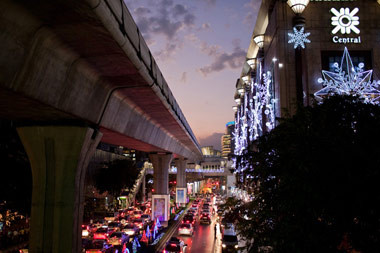
Driving a car and car ownership
The nature of the car market in Thailand is quite different to most Western countries. To start with, new car prices are a lot higher in Thailand than they are in the West. Example prices are as follows: A brand new Honda Civic 1.8 automatic is around 800,000+ baht = about $US 24K. A Honda Jazz new runs for around 600,000 baht and a fully optioned Toyota Corolla could get up to as much as 1,000,000 baht! If you look at cars with larger engines, prices become a lot higher than they are in the West. Car prices are dear due to the tax levied on them and the larger the engine capacity, the higher the tax rate. Luxury European cars can be outrageously expensive and forget the exotics like a Porsche or a Ferrari which are about 2.5 times the price for the same vehicle back home = silly money.
Cars devalue in price at a much slower rate in Thailand than they do in the West. Vehicles that are 7 or 8 years old with well over 100,000 km on the clock still sell for around 40 – 50% of the new vehicle price so with this in mind, buying new here is not the killer financially that it is elsewhere. Add to this that Thai driving standards are low and that the locals seem to prang their cars often and that servicing here is not that big a deal to a lot of people and you can suddenly see that buying new is not such a big deal after all.
Of course one can buy second-hand, but the prices are awfully high. And it is very difficult to buy a much older car, say as a run around. In the West, $US 1,500 or equivalent may get you an older, but perfectly reliable vehicle, the ideal run around that if something happens to it, you will not be significantly out of pocket. This amount of money in Bangkok would get you an absolute bomb. Even a 20 year old car will often go for around 100,000 baht! You often see taxis with 500,000+ km on the clock still going for 100 – 150K baht!
Car servicing is, as you would expect, a lot cheaper than in the West. Franchise dealerships charge around 350 baht per hour for labour. Parts cost much the same as the West. Go to a mechanic operating out of a corner garage and prices drop way down but would you trust their workmanship, especially with a near new car? If you have a ding, panel and paint work is very cheap and the quality of the workmanship seems to be very good. Just as well because it seems that everyone has a prang before too long.
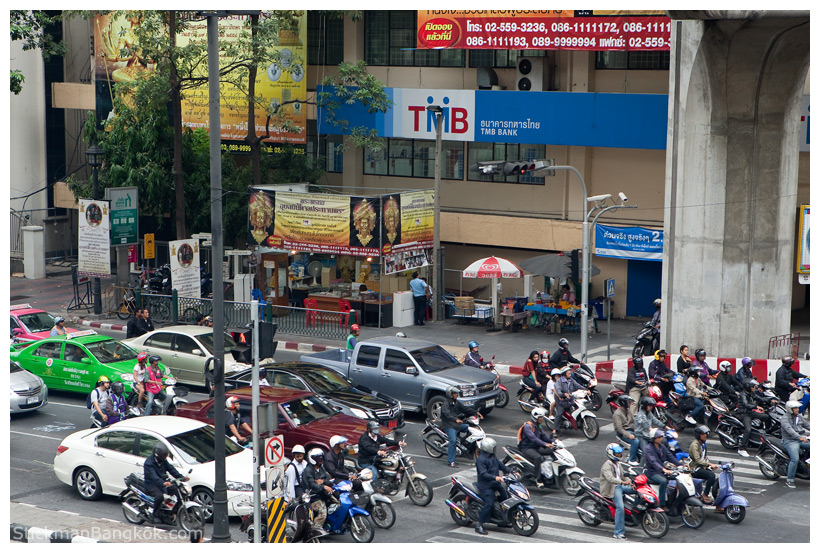
The list of difficulties when driving here is endless. The big one is obviously the driving standards which are abysmally bad. This all stems back from the driver testing and licensing system which is antiquated. Getting a Thai driver's license revolves around an easy written test, an eye test, attendance of a seminar on driving rules and regulations and a laughable practical test where you have to drive a car around a tiny circuit that proves simply that you can park a car – and frankly, little else.
Bangkok is notorious for its traffic jams, but give a Thai an empty stretch of road and they will put their foot down. Given the chance, they drive fast alright, it's just that it is not always possible. The bane of the Bangkok motorist is the army of motorcycles who zip in and out of lanes, squeezing in between cars and generally riding like men possessed. Cheap as can be, Bangkok must be home to a million or more, and few of them are ridden in a responsible way. I read somewhere that motorcycle accidents are one of the leading causes of deaths in Thailand and if it is indeed true, I am not at all surprised. Fortunately there is a reprieve for motorists known as the expressways. You have to pay a little extra to use them but motorbikes cannot go on them and usually the traffic flows well, apart from at peak hour. Basically, if you can use the expressway, do it. The small cost is offset by the amount of time saved and the reduction in stress.
The quality of the roads in Bangkok is variable but some of them are really horrible. Tight corners, camber that occasionally goes the wrong way, badly sealed or even heavily cracked roads with huge gaping potholes and poor signs all contribute to making a motorist's task of getting safely from A to B even tougher. It is horribly annoying to see the sign for exactly the place you were heading for AFTER the street or turn off. Not uncommon at all. And doing a U-turn or trying to go back can be a real nightmare. If you get lost, you can waste a huge amount of time. Bangkok is largely flat and there isn't a lot in the way of landmarks, so do expect to lose your way once or twice!
Personally, I have had no problems with the police in Thailand EXCEPT for when I have been behind the wheel of a car. Police checkpoints are numerous and one can find themselves being pulled over often – easily as often as once a month. (In fact some of my friends complain about being pulled over EVERY week – in some neighbourhoods such as the Rama 3 area the cops are out in force often.) Often it is just a quick check to make sure that your vehicle registration is up to date and that the driver holds a valid license. However, it seems that just as often, you are accused of doing something that you never actually did! This is a shakedown for a small donation to the “feed a policeman's mia noi” fund.
I personally have no problem with slipping a copper 100 baht if I have indeed broken the law, but I resent being shaken down when I drive more safely than most of the population. Yep, white skin and a big nose will make you become awfully popular with the boys in brown. There is more in the section on dealing with police on just how the “transaction” takes place.
Many people have told me that insurance costs are a lot more here than in the West, but my experience is that they are much the same. The cost of insuring a brand new vehicle worth, say, 800,000 baht is around 15,000 – 20,000 baht. If you have an accident, the first thing you should do, once you have established that you're ok, is call the insurance company who will send out a representative. That person will handle things for you. I gather that if (when?!) you have an accident, you are not supposed to move your car until a copy comes along. He will make the ground where the accident happened at which point you are allowed to move it.
baht. If you have an accident, the first thing you should do, once you have established that you're ok, is call the insurance company who will send out a representative. That person will handle things for you. I gather that if (when?!) you have an accident, you are not supposed to move your car until a copy comes along. He will make the ground where the accident happened at which point you are allowed to move it.
Drink driving is a major problem, not just with the locals, but unfortunately, with expats too. I don't want to lecture anyone on driving safety, but there is something seriously wrong when an expat jumps into his car after having just sunk 10 or more beers. I hate to say it but I see it all the time. While this sort of thing is considered downright wrong and is rapidly becoming socially unacceptable in the West, it is common enough here – and even if caught, a couple of hundred baht will not only see the cop disinterested in you, but he will no doubt allow you to continue on your journey, irrespective of the state that you are in.
It should also be noted that in 2008 the government introduced laws prohibiting the use of mobile phones while driving a car and they have been cracking down on it big time! Police officers have been issued with digital cameras to photograph people chatting on the phone while driving with infringement notices and fines sent to the vehicle owner in the post. Using a mobile with a hands free kit is ok, but holding it or wedging it between your shoulder and ear while driving is now very much illegal!
Thankfully, once you get out of Bangkok, traffic is much lighter and driving is more like the pleasure that it can be in the West.
It's a big ask to be able to justify purchasing and / or using a car in Bangkok. Generally public transport will get out where you want to go faster, less stressfully and in the long run, it will be cheaper too. Still, there is a certain convenience in having a car, especially when it comes to getting away from the city at the weekend and holiday periods. If nothing else, there is a great deal of prestige and face associated with car ownership in Thailand. If you own a car, you are someone! But the for me the big thing, and something which I think is seriously under-rated in Bangkok, is that travelling by private car is in many ways stress free. Whatever other method you choose to travel will be fraught with many pitfalls and there is something placating about sitting in your own car, listening to the music of your choice and not having to put up with other people and their noise. Yep, even on the crazy streets of Bangkok, driving can be one of the most relaxing options of getting around.
There are a number of scams that are pulled out gas stations and the two most popular are the gas station attendants failing to zero the pumps when they start filling up your car, so that the counter might actually start at 100 baht, or even higher, you paying for the previous person's gas (which they had already paid for themselves) as well as the gas for you. The other one is when you ask for your car to be filled up, the gas station will zero the pump as soon as it is filled, quoting you a higher price than it should be. This sort of thing is annoyingly common.
And with petrol prices soaring these days, many people are electing to go for pick up trucks and the like. These vehicles are included in a lower tax bracket than regular sedans and thus the purchase price is a lot lower. The price of diesel was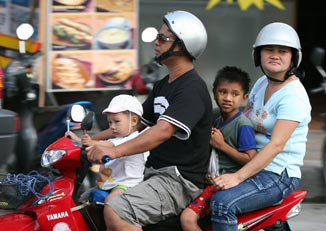 pegged for a long time at 14.59 baht per litre, meaning the government was subsidizing it to the tune of 3 baht a litre, for every litre sold nationwide. but this subsidy cost the government billions and in February 2005, the subsidy was removed and diesel is now sold at the market rate. Still, even with diesel now sold at its true price, if finances are tight, a pick up might be the way to go.
pegged for a long time at 14.59 baht per litre, meaning the government was subsidizing it to the tune of 3 baht a litre, for every litre sold nationwide. but this subsidy cost the government billions and in February 2005, the subsidy was removed and diesel is now sold at the market rate. Still, even with diesel now sold at its true price, if finances are tight, a pick up might be the way to go.
Of course, if you have a lot of money, you can always buy your own car or motorbike. Cars are relatively expensive here due to a luxury goods tax imposed on them and other than Singapore, I don't know of any countries where you'll pay more for a car. As an example, a new top of the line Honda Civic with the usual extras will cost about 800,000 baht. Used cars seem to hold their value pretty well and do not depreciate nearly as much or as fast as they do elsewhere in the world. If you hunt around, you can get a good deal on a used car but you will still end up paying a lot more than you would in the West. The problem with car ownership in Bangkok is not only the dreadful traffic jams but also the fact that parking is hard to come by. The major shopping areas and entertainment complexes do have car parks and they are usually very reasonably priced if not free, but often they are full and sometimes even the parking buildings have traffic jams and gridlock (witness the Panthip Plaza car park!) A car is useful for jaunts out of Bangkok or maybe if you live in the outskirts of Bangkok and commute in that immediate vicinity but once you actually come in towards central Bangkok, driving a car becomes a real chore and the traffic jams will no doubt contribute towards driving your blood pressure through the roof. Further, roads here can be poorly sealed, signed (usually signs are in both English and Thai but not always) and some of the unmarked super sharp corners are nightmare material. You can always buy a motorbike and a little get-around-town like a Honda Dream can be very cheap. Still, it's a brave man who jumps on a bike in this city. I've seen too many accidents for comfort and if I am going to get on a bike, I am sure as hell not going to ride it myself for that would truly be a disaster! If you didn't know, they drive on the left in Thailand – most of the time. Finally, with regard to car ownership is the service history – insist in getting a car with a full dealer history. Like many others in Asia, particularly the Japanese, many Thais seem to just drive and drive their car until something goes wrong before getting it serviced – and some of the places where they get them serviced look pretty damned dodgy too.
Travelling by bus
The cheapest and most extensive network for getting around Bangkok is the bus system. There are several different classes of bus ranging from the 5 baht small Mercedes green buses and the huge fleet of red buses, the white buses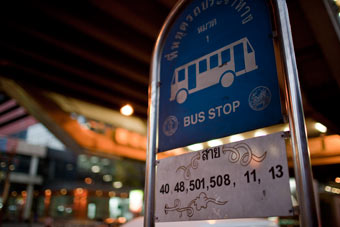 with fans, the older blue air-con buses, the new blue air-con buses, the modern air-conditioned orange buses and the Microbus company. Don't worry, it doesn't take long to figure them all out. The red and the green buses drive around with the windows down which allows a cool breeze to flow through the bus, helping to keep you cool. Most of the year these are ok, but in the hot season, one really wants to get on an air-con bus if possible. However, the red and green buses can get a bit hot and sticky if you are stuck in traffic and the bus isn't moving and therefore there is no breeze flowing through.
with fans, the older blue air-con buses, the new blue air-con buses, the modern air-conditioned orange buses and the Microbus company. Don't worry, it doesn't take long to figure them all out. The red and the green buses drive around with the windows down which allows a cool breeze to flow through the bus, helping to keep you cool. Most of the year these are ok, but in the hot season, one really wants to get on an air-con bus if possible. However, the red and green buses can get a bit hot and sticky if you are stuck in traffic and the bus isn't moving and therefore there is no breeze flowing through.
If you're on a budget, or want to get a feel for the city, bus travel sure helps that. Admittedly it is somewhat slow, but travelling around somewhat slowly with the vehicle stopping frequently gives you a unique chance to really get a feel for Bangkok. If this appeals, buying yourself a bus map is one of the first things that you should do when you arrive in Bangkok. Although it may seem confusing at first, the buses operate an efficient and very cheap service and if you want to save money, you should utilise them as much as possible. Buses are so cheap that it almost makes transport costs seem as though they are free. Unfortunately, while the prices may be cheap, this is offset by some of the drivers who appear to have a death wish and drive like absolute dickheads. Speeding along at breakneck speeds, literally standing on the breaks and overtaking at the worst places may all seem like a bit of a joke at first, but when you realise that almost every driver is like this, you do get a bit worried about your personal safety. The red bus (far and away the most common type) drivers are easily the worst. The drivers of the newer air-con buses seem to be a little more careful – only Buddha would know why.
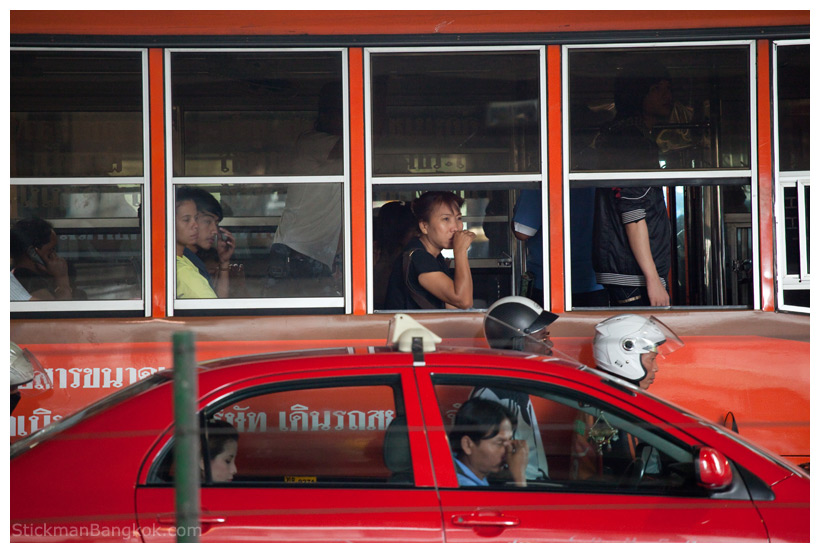
All of the buses are numbered and usually have their destination listed on the side of the bus. These signs used to be in Thai only but a number of buses, particularly those that ply routes popular with foreigners, now have signs in English too which is very helpful. Once you have got onto the bus, you pay the conductor who roams around but frequently misses passengers. Don't worry though – you are a farang and stand out and it is unlikely that he / she will miss you! The buses are cheap and range from 3.5 baht for the small green buses or the red buses up to 16 baht for a long journey on one of the blue air-conditioned buses. Buses run frequently and some routes run 24 hours. Take note of the bus numbers that pass by your apartment or the areas that you live or frequent. If you are out and about in an area that you are unfamiliar with and want to return to your apartment, you may notice a bus with a number that you recognise from home passing by. Jump on and it will take you back to the area where you live – saving you an unnecessary taxi fare. At certain times of the day, particularly peak times and late at night when few buses are running, the buses can get ridiculously overcrowded with people hanging out of the doors and those inside barely being able to move. Crowded buses can be a haven for pickpockets so be careful – especially ladies carrying handbags as these seem to be the biggest target. It seems that less and less Westerners in Thailand use the buses these days. The bus services are fine and are certainly cheap, but they can get really, really crowded, so much so that it can be hard to get off and if you are on a really crowded but and know your stop is coming, try and make your way to the exit – though that can be more easily said than done.
Bus, and indeed public transport etiquette, is very different in Thailand to the West. Unlike the West where a child may offer or be forced to surrender their seat to a full paying customer, in Thailand it is the opposite and you will often see an adult giving up their seat for a young child! Still strikes me as bizarre this but I guess it goes along with the way that Thais seem to spoil their children. Obviously, decent folk will offer their seat to the elderly, the pregnant and those who are invalided. Note that there is a single ticket price on public transport and there are no discounts for children or oldies (senior citizens to you PC folks). Infants do ride free though.
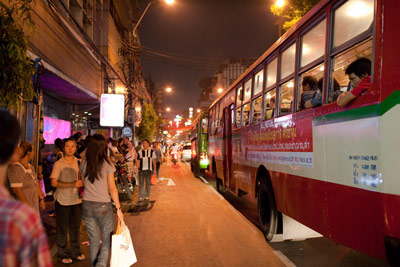
The late '90s saw the introduction of the Lady Bus and the Culture Bus. The Lady Buses ran on a few of the more popular routes on the last few days of the month. Petty crime had been a problem on the buses, particularly theft around the end of the month (when everyone gets paid) and it was often women who were often the victims. Further, a lot of Thai woman complain that Thai men "rub themselves up against the women using conspicuous parts of their body"…hence the introduction of these buses. Men cannot get on board. Don't worry, they have large pink signs in both English and Thai clearly saying Lady Bus so you can't miss them. The culture buses were introduced after the Lady Bus and I have yet to work out exactly how they differ from the regular buses but someone told me that on these buses, men are compelled to offer their seat to women if all other seats are taken! In a country where men have far more power and status than women, I have yet to figure out why this is termed the "culture bus". I do not know if the lady buses or the culture buses still operate. I think they were done away with. A novel concept that may not have worked.
The Microbuses are a more comfortable alternative to the city run bus service in that once all of the seats are full (no-one stands on one of these buses), the driver will not pick up anyone else. You pay the driver when you get on and a flat rate fare of 25 baht is charged, irrespective of the destination. These buses are more comfortable and sometimes have a TV on board and occasionally even free newspapers. Like the lady bus and culture bus, I am not sure if the Microbuses still run these days or not. I haven't used a bus in a few years, and don't recall seeing the Microbuses any more, so this paragraph may be largely redundant.
The reality of the situation is that the longer people stay in Bangkok, the less and less they tend to use the buses. Taxis are cheap and the skytrain and underground service much of the area where Westerners live and play, so there is no real need to use the buses. Bangkok buses are far from comfortable as they can get horribly crowded and even if you do manage to get a seat, you might find yourself with passengers around you, almost sitting on top of you. If the bus that you are on is really crowded – as they often get – be aware of when your stop is approaching and TRY and make your way to the door. Many a time I've been stuck near the back, trying to get near the door, but ultimately finding it an impossible task – and the bus had long past my intended stop by the time I actually managed to make it to the exit! Also, be careful how you position yourself. If you lift one foot of the ground, perhaps to scratch the back of your other leg or something like that, when you go to put it back down there may not be any space to put it!
If you want a lesson in the politeness of Thai people, watch how they orderly queue to get on and off a bus… Unfortunately, you will quickly learn that the only way to survive is to follow their example and barge your way on and off the buses too. Note that sometimes the buses don't actually stop – you may have to jump on or off while it is moving – albeit moving very slowly. And always keep an eye out when you get off a bus as it is not at all uncommon for motorcycles to pass buses on the inside, between the bus and the curb – very dangerous but hey, this is Thailand!
Monks ride on the buses for free and will take the seat on the left hand side, immediately behind the door. If the bus is full when a monk gets on board, whoever is in that seat will stand up and allow the monk to take the seat. Men are allowed to sit next to monks but women cannot due to monks not being allowed to touch, or be touched by, women.
Bus routes do change from time to time so you need to keep abreast of these changes if it is a route that you are dependent upon for work or important social events! Unfortunately, this is somewhat difficult for most people as the changes are usually announced in the form of a notice inside the bus IN THAI. Another thing to be aware of is that on some routes (29, 8 and 11 spring to mind), some buses will use the expressway, while others won't. Buses taking the expressway tend to operate at peak hours in an effort to get people into or out of the city quickly and usually operate on the longer routes. The sign for expressway, again, is only in Thai. Usually it is a largish yellow notice, placed both inside the front window and also next to the entrance / exit.
Bus prices are as follows, although with the price of fuel skyrocketing, these may become out of date fast!
- Small green buses 7 baht
- Red buses 10 baht
- White buses with fans 10 baht
- Older blue air-con buses 12 – 20 baht
- Newer blue / orange air-con buses 14 – 24 baht
- Microbuses 25 baht
While one can get by using the bus service, they are not at all comfortable and you can waste a lot of time as they are relatively slow. The only farangs using the buses regularly tend to be budget tourists or underpaid English teachers.
Taxis
Bangkok has perhaps the cheapest reasonable standard metered taxis of any capital city in the world. Bangkok taxis are metered and the taxi driver is obliged to use the meter. That said, if he perceives that you are new to the city or do not know your way around nor know the etiquette, he might try and negotiate a price upfront which will always be in his favour, more than the trip would cost by meter. Only take a taxi if the driver turns on the meter. If the driver, 99.9% of them are male, wants to negotiate a fare, just get out of the taxi and get into another and odds are that the driver will agree to use the meter unless he is one of the lazy buggers who waits in a heavily touristed area waiting for a sucker tourist who will accept the negotiated price and he therefore gets a prime fare.
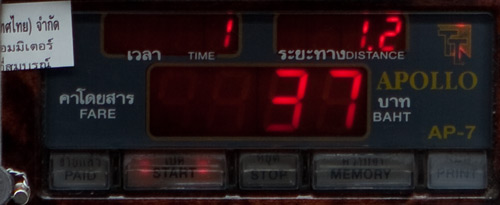
A relatively small percentage of Bangkok's taxi drivers are actually Bangkok born and raised career taxi drivers. Some drivers are moonlighting – they have another job but driving the cab gets them some extra income – their other job may be anything from a labourer to a cop! The biggest group of all the taxi drivers is upcountry folk, predominantly from Isaan and many of them are rice farmers! Yep, when the rice needs planting or collecting, or whatever they do with it, the farmer heads upcountry to tend to the family rice fields and when the work on the farm is complete, he makes his way back down to Bangkok and gets behind the wheel of a cab. Remember, upcountry there are not nearly so many opportunities for work so the good upcountry folk come down to the big smoke in the pursuit of employment. It seems the majority of the drivers fall into this latter group.
With this in mind, if the driver has not been in Bangkok for a long time, he might not know the best way to get to your destination. While you may be inclined to believe that his lack of knowledge of the streets is a scam or that he is taking you home via the long route so he can charge you more, that is actually very, very unlikely! The take the long route home scam is just not practiced here. The reason he is taking you an odd way might simply be that he doesn't know the best way OR he does know a route that is quicker than the route you know. The Thai words for directions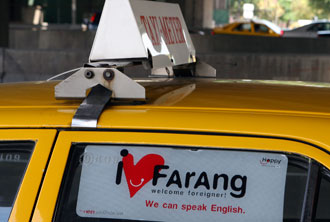 should be one of the first things you learn in Thai! Drivers prefer to take the expressway because it will be quicker – but that is surely good for both you and him. Obviously in such cases you pay the expressway fare.
should be one of the first things you learn in Thai! Drivers prefer to take the expressway because it will be quicker – but that is surely good for both you and him. Obviously in such cases you pay the expressway fare.
The cabs drivers are almost entirely male (females make up about 1% of all of the drivers, if that). While they may predominantly come from the poorest parts of the country, the drivers are still able to speak enough English for most foreigners to manage to communicate where they want to go. There have been various initiatives over the years to help taxi drivers improve their English so that they can provide better service to foreigners and now you can see signs like the one here stating that the driver is comfortable with English.
When telling the driver your destination, it is usually best to talk rather than show him a map or give him an address written in English. Maps are not easily negotiated by taxi drivers and you will often see them holding a map, nodding away that they know exactly where you mean, yet they are looking at it upside down! An address in Thai or a brochure of the hotel that you are going to with an address in Thai is better.
I much prefer to get into a cab with an older driver than a young guy. The older drivers tend to driver better i.e. not as fast, and they tend to be more polite. Some of the young drivers can be quite rude, and can be a bit hot-tempered, driving way too fast and doing some silly things behind the wheel. I also tend to get into newer cabs rather than the old ones. Bangkok cabs run 24/7 and they get beat up pretty fast. If you are going to be stuck in the cab for a while I figure you may as well choose one that looks a bit more comfortable.
Many of the cab drivers do stupid things behind the wheel and with there usually being no seatbelts fitted into the rear of cabs, you can sometimes feel like your life is very much in a stranger's hands. There was a very sad news item in September 2007 when a young female Australian resident in Bangkok was killed in a taxi. A speeding driver caused a 4 car crash and the poor Australian girl broke her neck and died at the scene. Fatalities in cab accidents are a very real issue…
There was an article in the Bangkok Post once about how there is a surplus of about 20,000 taxis in Bangkok so if one driver refuses to turn on the meter, getting another one will be no problem. After 11:00 PM, it seems that more than half of the cars on the road are taxis. Note that in the rainy season, getting a taxi may be a little trickier when the rain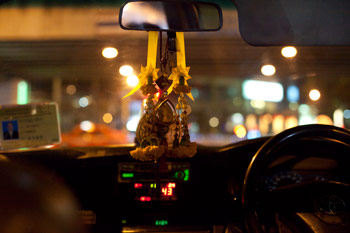 is pelting down. Just before it rains, a taxi driver may refuse to pick up passengers because when it starts raining, he will have no problem getting a fare and may attempt to negotiate an extortionate fare. When it rains, the taxis fill up quickly and getting one can be a lot more difficult.
is pelting down. Just before it rains, a taxi driver may refuse to pick up passengers because when it starts raining, he will have no problem getting a fare and may attempt to negotiate an extortionate fare. When it rains, the taxis fill up quickly and getting one can be a lot more difficult.
The taxi flag fall is 35 baht and this includes the first kilometre. After that it is around 5 baht per kilometre for the next 10 km and the rate gradually increases the longer your journey, up to 8 baht a kilometre. Often the taxi is stuck in traffic and in this case, when the taxi is moving at less than 6 km per hour, you pay a supplementary 1.25 baht premium per minute. Taxi fares increased in mid 2008 for the first time since 1994 but still remain a very inexpensive means of getting around.
I used to recommend the yellow and green taxis. These are driven by owner / operators or the folks that the owner subleases the car to and in my experiences they were less likely to have any problems. I have since found that the blue and red taxis seem to be slightly newer and have less wear and tear. But really, it is a bit of a lottery with the particular car that you get in. The general condition of taxis varies from vehicle to vehicle with some being new, comfortable and clean, while there are others are absolutely awful. Awful can mean anything from old to having clapped-out suspension which sends vibrations up your back as the cab goes over bumps to the worst of all, those where the air-con doesn't work.
The odd cab may have a dodgy meter but don't let this concern you too much, I have only had a handful of taxis with obviously rigged meters in all my years here, and even then, the extra cost was perhaps only 20 baht. Yeah, the principle of it is bad, but at the end of the day, 20 baht won't break the bank. One time I was taking a journey of a route that I used to take often. I knew the exact distance and the usual fare which fluctuated depending on whether the taxi was caught in traffic or not. I didn't take any notice of the fare until we arrived and when we got there, the distance was twice the usual BUT we had taken the same route. I casually mentioned this to the driver in Thai who suddenly got extremely nervous. Apparently diddling the meter is quite a serious crime so when I said that I would pay what the fare should have been, the driver seemed quite relieved.
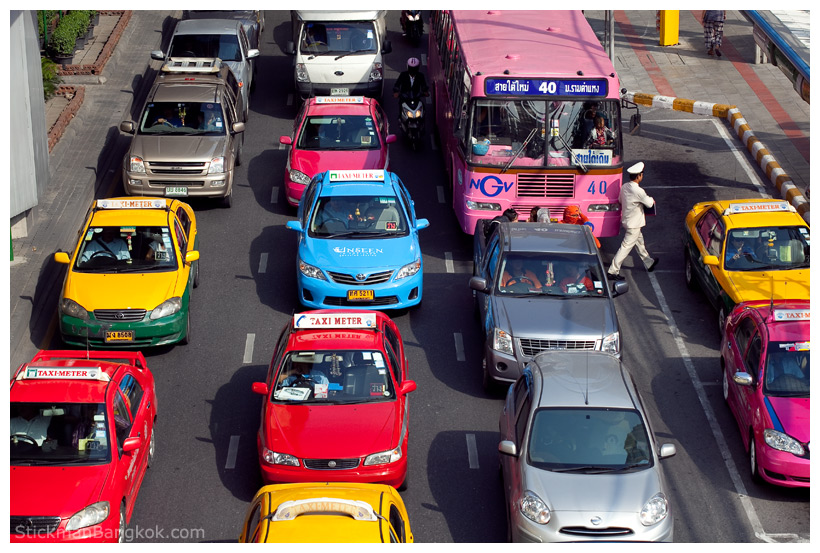
Most of the taxi companies hire the cars out to drivers by the day. I have heard various figures banded around but it seems that 500 a day is the average, though for a bit less they can get a real clunker! The driver then has the car for twelve hours and it is up to them to make as much money as they can before they return it. Some of them will do OK but others will struggle – a lot of it comes down to luck. Folks who speak little or no Thai may struggle with some of the taxi drivers who can play silly games from time to time but if your Thai is ok, they will usually be fine. Just like when getting out of buses, you need to be aware of the countless motorcycles passing on the inside, between the footpath and the taxi and many a time have I seen a taxi door opened on a moving motorcycle driver. CRASH! The results are messy and as a farang, you may be pressured to foot the bill – even though what the motorcycle rider is doing, passing on the left, is technically illegal. Many taxi drivers do drive like absolute maniacs, fast when there is a stretch of open road in front of them and zipping in and out of traffic in an effort to get you to your destination as fast as possible. Apart from their dreadful driving, I find most of them to be very pleasant and always enjoy chatting with them, even if the conversation is much the same every time. They are just decent upcountry folks trying to eek out a living. Despite the fact that I am tight with money and despite the fact that many of them drive appallingly bad, I almost always tip them. My choice, and whether you choose to do so is up to you. I reckon they are underpaid and I know I couldn't do their job, driving in Bangkok traffic, 12 hours a day, everyday. Even though the cost of petrol has gone up by a huge amount over the last few years, taxi fares have not gone up at all. Though that said, 95%+ of the cabs run on natural gas.
TukTuks
Tuktuks are a novel way of getting around and if you can negotiate a price that you know is cheaper than or about the same as a taxi far would be then perhaps you may care to take one. However, tuktuk drivers can be a greedy bunch and they will fleece you if you do not know what the corresponding taxi fare would be and with this in mind they are therefore best used for routes you are familiar with. It helps to speak some Thai to negotiate with the drivers as most of them are from small villages in the Northeast of the country and speak little English. Being a foreigner, they will immediately quote an outrageous price – often about twice what an air-con taxi would be! As in many circumstances, speaking some Thai will give you a real advantage. Tuktuk drivers are another bunch who drive like absolute maniacs and being a passenger in a tuktuk is not for the faint-hearted. You also get an unlimited free sample of Bangkok's heavily polluted air on a tuktuk ride. Remember, tuktuks have little in the way of safety features for the passenger and accidents can be fatal. If you've seen how badly tuktuks fold up in accidents, odds are you would never want to use one.
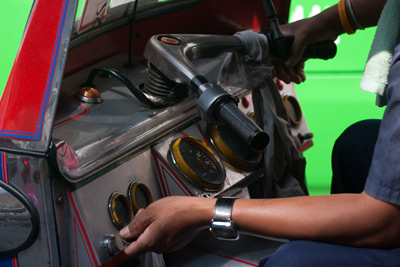
Beware of tuktuk drivers who offer to take you on a "shopping trip" or to a gem store / tailor's store / duty free shop. Also, beware of tuktuk drivers who want to take you somewhere of their choice for a low 10 or 20 baht. They will make out that these stores are something special but believe me, they aren't and they're only taking you to these stores as they will get a commission if you buy anything. You can waste a lot of time if you accept one of their seemingly kind offers. Still, whenever I have friends visit me in Bangkok, I always take them around in tuktuks for the novelty value. Perhaps the best way to overcome these silly unwanted city tours is to hail a cab or tuktuk that is actually driving along the road – they will be keen to take you where ever, usually without a problem. The fellows who park up in predominantly heavily touristed areas would rather wait for one big fare from a tourist than 4 or 5 smaller fares from locals – lazy buggers! What's a fair price in a tuktuk? Hard to say but I usually pay about the same to 20% less than the same journey would cost in a taxi so if it's 50 baht in a taxi, I usually find that with a bit of haggling, 40 baht can be achieved. It's novel to watch Thai high school students get into a tuktuk, often immediately after school and on their way to the local shopping centre. Sometimes they get 10 or more of them (yes, really, hanging on the outside and all!) in a tuktuk with some of the kids sitting on top of each other, at least one hanging out each side and three perched on the back.
Samlors
There are some samlors (in Thai, this means three wheels, but they are known in other parts of Asia as trishaws or rickshaws) in a few of the outer suburbs of Bangkok but these tend to be less common in he capital and more common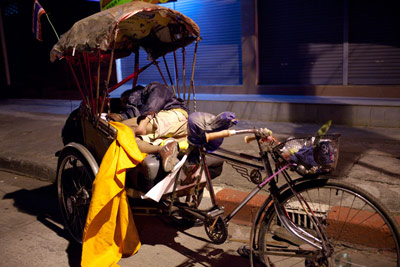 in the provinces. Budget on about 20 – 30 baht per kilometre and ALWAYS agree on the price before the journey. (You can get rides on them for less in the provinces.) I had a nasty experience with a samlor rider in Kanchanaburi who tried to charge an outrageous price in a dispute that had to be settled by the local boys in brown. You will not see these anywhere in central Bangkok though they are popular and usually very reasonably priced in most other parts of Thailand. There is a certain romance about the samlor, but really, they are a slow form of transport and best used if you are in no hurry! While samlor journeys should be cheaper than a taxi, the drivers are usually old and doddery and with many years spent peddling in chaotic traffic are lucky if they can even hear you, let alone understand any of that funny mumbo jumbo that we call English! It has been my experience that you can usually get a better deal in a tuktuk. Samlors are seen less and less frequently in Bangkok – you only see them in the suburbs in the very outskirts now – and in the next ten years, there is talk that they may even become extinct. That would be said for there is a certain romance associated with them.
in the provinces. Budget on about 20 – 30 baht per kilometre and ALWAYS agree on the price before the journey. (You can get rides on them for less in the provinces.) I had a nasty experience with a samlor rider in Kanchanaburi who tried to charge an outrageous price in a dispute that had to be settled by the local boys in brown. You will not see these anywhere in central Bangkok though they are popular and usually very reasonably priced in most other parts of Thailand. There is a certain romance about the samlor, but really, they are a slow form of transport and best used if you are in no hurry! While samlor journeys should be cheaper than a taxi, the drivers are usually old and doddery and with many years spent peddling in chaotic traffic are lucky if they can even hear you, let alone understand any of that funny mumbo jumbo that we call English! It has been my experience that you can usually get a better deal in a tuktuk. Samlors are seen less and less frequently in Bangkok – you only see them in the suburbs in the very outskirts now – and in the next ten years, there is talk that they may even become extinct. That would be said for there is a certain romance associated with them.
Motorbike taxis
If you are in a real hurry and absolutely must get somewhere quickly, the best bet may be to take a motorcycle taxi. Motorcycle taxis were introduced to the city some time around 1990, when the city's traffic jams were said to be at their absolute worst. Motorcycle riders can be seen in clusters all over the city, usually parked at the end of sois, intersections or near busy shopping centres. They are easily identifiable by the vest that they wear – which used to be a different colour in different areas but these days is invariably orange, making the motorcycle taxi riders very easy to spot. It should be noted that unlike regular taxis, the cars that is, motorbike taxis do not roam around looking for customers but are domiciled to one spot where customers come to them. Once they have taken a customer to their destination, the motorcycle will return to their original location. They will not pick someone up at the destination where they just dropped someone off. Motorcycle taxis are not for the feint-hearted and in many ways, I do not recommend using a motorcycle taxi unless you absolutely need to get somewhere very quickly. Accidents are far too common and the result of them range from awful to fatal. I have to admit a fairly major case of hypocrisy here because as my life gets busier and busier – and as Bangkok traffic seems to get worse and worse, I find myself using these motorcycle taxis more and more often. However, one does need to understand the risks. A former American colleague of mine had two accidents in three months on motorcycle taxis – luckily he wasn't badly hurt in either of them.
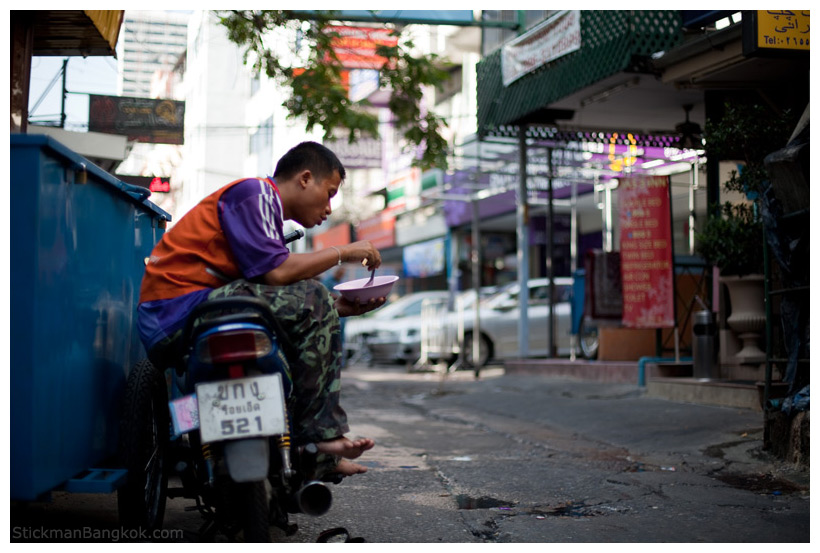
As with all road accidents in Thailand, the problem may not necessarily be the accident itself but what happens next. I have had the misfortune to see several motorcycle accidents and within seconds of the accident happening – and the results are messy. What ultimately happens is that the injured are picked up off the ground with little or no consultation as to their condition and hauled into the back of the nearest tuktuk or pickup truck which then takes them to the nearest hospital. So much for the idea of immobilising the person so as not to exacerbate any possible injuries! Obviously the same happens when a tuktuk or regular taxi is involved in a prang. It is just that the chances of serious injury is greater on a motorcycle taxi than in any other form of transport. Motorcycle taxis charge about the same as tuktuks and taxis for longer journeys but can be quite economical for shorter journeys, such as up and down a soi, when the cost may be as little as 5 or 10 baht. Prices for motorcycle taxis are often about the same as what it would cost in a metered taxi, the big advantage being the speed. Even in a traffic jam, they can weave their way in between cars and can get your to your destination quickly. Aside from the danger factor, beware taking them either when it is raining or just after it has rained and the roads are wet. Spray from the wheels of other vehicles will make whatever you are wearing absolutely filthy in no time. No white shirts on the motorbike taxis when it is raining because you'll never be able to clean them and your wife / maid will curse you no end! (Yep, I found this out the hard way!) The law says that everyone on a motorbike, both rider and passenger(s), must wear a helmet. In the case of motorbike taxis, it is the responsibility of the rider to provide you with a helmet. If stopped by police, the rider is liable for a 200 baht fine – usually a ticket is issued and he will pay it later. He might try and ask you for the 200 baht but you do NOT have to pay it. (Still, what were you doing on the back of one without a helmet – bloody dangerous!) 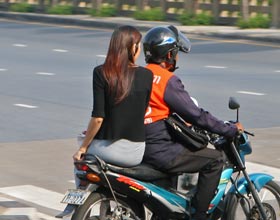 Police in areas where there are many farangs, such as Sukhumvit do not tend to be strict about this law, though police in other areas are. From time to time there are crackdowns on this. The 200 baht fine aside, surely you would want to protect your head with a helmet?
Police in areas where there are many farangs, such as Sukhumvit do not tend to be strict about this law, though police in other areas are. From time to time there are crackdowns on this. The 200 baht fine aside, surely you would want to protect your head with a helmet?
One sight that I still chuckle at in Thailand is the way that females tend to sit side-saddle when a passenger on a motorcycle, many of which travel at breakneck speeds with her on the back, seemingly quite comfortable and balanced. Even after many years living in Bangkok, this is one sight I still chuckle at. Just how do they manage it?!
Often you will see people jumping on the back of a motorcycle taxi being taken up and down long sois. The fare is usually 5 or 10 baht. These motorcycle taxis run up and down the same route all day long, saving the passenger from having to walk in the heat of the sun.
Baht buses / Songtaews
In the same mould of the soi motorcycle taxis are what are commonly referred to as baht buses – called songtaew in Thai. These vary from pickup trucks to the little converted Subarus as is pictured here to weird, largely unrecognizable vehicles. They usually have two rows of seats, one on either side of the vehicle. On long roads such as Sukhumvit soi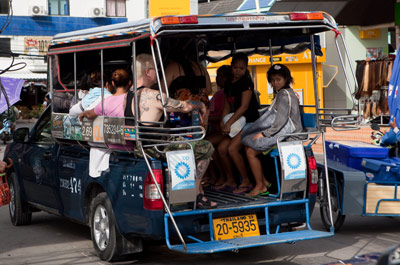 77 (Soi Onut) or ChokChai 4 Road of Lad Prao Road, where there are very few (and indeed sometimes no) bus routes, you will see the baht buses running up from one end of the street to the other. You simply jump on the back of the baht bus, which will stop if you wave it down and while on board, you press a button when you want to get off. Prices vary from area to area but are usually around 5 – 7 baht irrespective of where you get on and where you get off. These are very much a form of "local transport" and if you live in an area where such a service is operated, you'll quickly work out ho to use it.
77 (Soi Onut) or ChokChai 4 Road of Lad Prao Road, where there are very few (and indeed sometimes no) bus routes, you will see the baht buses running up from one end of the street to the other. You simply jump on the back of the baht bus, which will stop if you wave it down and while on board, you press a button when you want to get off. Prices vary from area to area but are usually around 5 – 7 baht irrespective of where you get on and where you get off. These are very much a form of "local transport" and if you live in an area where such a service is operated, you'll quickly work out ho to use it.
Boats
On some of the canals (klongs in Thai, a word that is often used in English by Westerners resident in Thailand) are river boats that run commuters up and down the city's canals, stopping at the makeshift jetties. While cheap, you really need to know where you are going – though getting lost can be part of the fun! Travelling by this means is very fast compared to road based means of transport and therefore saves a lot of time. The boats, like the taxis, are also relatively cheap. Getting on and off the boats can be a bit of fun – mind you don't slip into the canal! Some of the klong boats are cancelled if the weather in the monsoon season gets really bad but this is typically only a handful of days each year. The aroma of the klongs is one of Bangkok's treats! A typical klong boat, one of the boats that runs up and down the Saen Saeb Klong, is pictured below. The Saen Saeb klong canal boat runs a very useful route from way out past Ramkhamhaeng in the northeast of the city, through to The Mall Bangkapi, down along Petchaburi Road to The Central World Plaza where the main hub is and then on to Rachadarmnoen Road, not too far from Khao Sarn Road. Depending on the distance you travel, the cost was from 5 – 15 baht although I have not used them for a few years and I imagine prices have crept up a few baht.
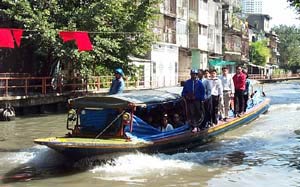
Canal boats can be convenient, but be careful getting on and off!
An excellent way to get around is the Chao Praya Express Boat that runs up and down the Chao Praya River, the main river in Bangkok. It goes from Nonthaburi in the north of the city, all the way down to an area south of Sathorn Road. It is very reasonably priced at a flat rate 13 baht, irrespective of how far you go. Apart from using the service to get around, this boat is a bit of a tourist attraction and it is well worth getting on it and running from one end of the route to the other as you get an excellent view of Thailand's most famous and busiest river. Sit back and enjoy the ride. Up and down the Chao Praya River at various points you can find river ferries that cross the river from one side to the other and the cost is just 3 baht.
Bangkok by foot
I have always enjoyed walking as a means of getting around. However, in Bangkok, with the unabating heat and the dreadful state of the footpaths, you may want to re-consider the idea of pounding the pavement. The footpaths are a mess, with huge holes and in many places very poorly laid tiles / brickwork. In addition to this, and as much as I hate to criticise, Thais tend not to like walking and when they do, they walk at a snails pace and they walk like they drive – bloody appallingly – zigzagging backwards and forwards without any indication of the next movement! If you happen to find yourself walking behind a bunch of Thais and you are trying to get past them, try and gently get past because even if they are aware that you are behind them and want to get past, they will not necessarily make way. They seem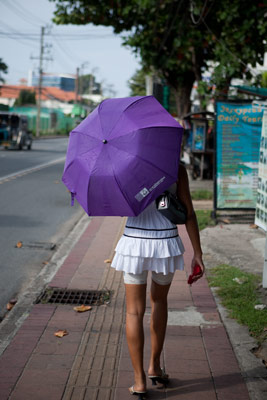 to weave their way all over the show without any real pattern to the route they are taking. The other annoying habit that they have when they walk is that they often don't look where they are going! It often seems that they scan ahead to make sure that there aren't any fixed objects in their way but they don't seem to consider that maybe someone might walk into that space. So, as they are walking in one direction, they are often looking somewhere else! It can be frustrating at the best of times! If you are looking at a Bangkok map and see the place you want to go to and it looks like it is in walking distance, think again.
to weave their way all over the show without any real pattern to the route they are taking. The other annoying habit that they have when they walk is that they often don't look where they are going! It often seems that they scan ahead to make sure that there aren't any fixed objects in their way but they don't seem to consider that maybe someone might walk into that space. So, as they are walking in one direction, they are often looking somewhere else! It can be frustrating at the best of times! If you are looking at a Bangkok map and see the place you want to go to and it looks like it is in walking distance, think again.
Walking can be a slow, energy sapping process and unless you are walking in the cool season, you will likely arrive at your destination a sweaty, smelly mess, something which is seriously uncool in Thailand. Be very careful when you cross the road and even if it is a one way street, remember to look both ways! With the traffic being very heavy, it can be difficult to cross the road and there are a lot of pedestrian over-bridges allowing you to cross the road without risking your life on the tarmac itself. Sometimes you may have to walk a bit out of your way to find a pedestrian over-bridge but believe me, it is best to do so. (In 2003 there have been a number of muggings and robberies and even rapes on some of these over-bridges late at night. While the victims are predominantly women (and the readership of this website is predominantly men) it still pays to be careful.)) The Thais don't like walking anything more than a very short distance – Westerners who have lived here a while tend to emulate this pattern but I am an exception and walk as much as possible – gotta work off all that beer! Lastly, the footpath is not always the domain of the pedestrian. Cars, tuktuks, motorbikes and even the occasional elephant can be seen making their way down the footpath and other than the poor old elephant, all of the others move along at a fairly dangerous speed so be careful! While in the west we would fiercely hold our ground if a cyclist approached us on what is obviously a pedestrian walk way, it is not like that in Bangkok. It often seems that people give way to the biggest vehicle so in the best interests of self preservation it is best to allow bikes to pass by unhindered.
In early 2000, a silly wire fence was erected on Silom, Sukhumvit and Rama 1 Roads, right in the middle of the road, preventing pedestrians from crossing except at marked crossings and pedestrian bridges. There used to be signs quite clearly in both Thai AND English stating that there is a 200 baht fine for jaywalking so beware – though these signs seem to have been taken down. Another law that one needs to be aware of is the "littering law". I truly believe that this law was introduced as an instrument to derive an extra "tax" out of foreigners. If you drop rubbish on the streets of Bangkok and either a policeman or one of the "litter officers" (uniform similar to a policeman but with a green badge on the shoulder and no gun or handcuffs) spots you, you are liable for a 2000 baht fine. In fact in some tourist areas, it doesn't even say fine 2000 baht – it says fine $US 50 – see what I mean about targeting foreigners! If you are stupid enough to drop litter and you get caught, this can obviously be negotiated down – figure on 100 – 500 baht, depending on whether you speak Thai or not. It doesn't matter what you drop, even a cigarette butt is enough for them to nab you. It is my understanding that for the police to successfully get you on this charge, they need to retrieve whatever it was you disposed of. If it looks like they are about to grab it and there is a chance that you can, for instance, push it down a drain from where it can't be retrieved, then it is worth doing that. No, I don't condone it, but hell, if it is going to help you avoid a fine, then you've gotta do what you've gotta do!
If you are planning on doing a lot of walking, you seriously need to think about footwear. There are two viewpoints you can take here. Some people prefer open footwear like sandals or thongs that allow your feet to "breathe". Others, like me, prefer a good solid pair of solid shoes, such as hiking boots, which provide protection from the poorly constructed footpaths and roads. The footpaths in Bangkok are real shoe killers and I'd rather they killed my shoes than my feet! The only thing about walking in Bangkok is that while you see a lot more with regards to what is happening on the streets, all the street life, vendors etc, the city is hardly pleasing on the eye. Still, just the atmosphere alone on the streets is enough to keep me on foot – along with all of the great street vendor food.
Skytrain (BTS) and the underground
The skytrain development stage 1 has finished and it provides an easy way to get between the Silom, Siam Square, Sukhumvit and Chatuchak areas. There are plans in store for it to extend a lot further into the suburbs of Bangkok and when that happens, Bangkok will really start to open up. While it may be useful, this ugly monstrosity dominates what is hardly a pretty city but certainly helps getting around. The fares have been set in a progressive range from 15 – 40 baht. This is not actually that cheap and if there are two or more of you, it may in fact be cheaper to take a taxi, but likely slower with Bangkok's traffic. However, for speed, the skytrain cannot be beaten. An all day pass, allowing unlimited rides on the skytrain (note: skytrain only, NOT the underground, costs 120 baht.)
If you use the sky train regularly, you should consider buying one of the stored value cards. Basically, it is just a card with a credit on it. If you don't have a stored value credit, you usually have to queue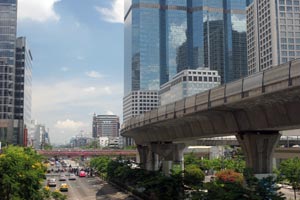 up to get change for the ticket machines, and then queue up for the machines themselves. If you have a student card (they only accept Thai student cards) then you used to get a 35% discount. You can buy a 30 ride card for 540 baht which equals 18 baht per ride, a very good deal for people who use it every day. If you are taking rides of three stations or more, then this will work out in your favour. Just note that the card has a limit of one month within which all of the rides must be used. There is a student card which gets 30 rides for 360 baht, just 12 baht a card but buying one of these without a student ID may be a little tricky… For the snobs out there, some consider the skytrain to be the most civilized form of transport and I must admit that the fact that it doesn't suffer graffiti or louts like many comparable subways in other countries is a good thing. The skytrain operates from just before 6:00 AM until just after midnight and very occasionally runs 24 hours – such as New Years Eve. You never have to wait too long for a train, though wait a little longer at night than during the day, when there are fewer passengers. At every skytrain station you get the officious security guards who enjoy blowing their whistle at you and getting in a song and dance if you cross the yellow line, near the platform, when the train is not there. Actually, it's quite funny playing games with them and then pretending that you don't speak Thai when they try to say something to you!
up to get change for the ticket machines, and then queue up for the machines themselves. If you have a student card (they only accept Thai student cards) then you used to get a 35% discount. You can buy a 30 ride card for 540 baht which equals 18 baht per ride, a very good deal for people who use it every day. If you are taking rides of three stations or more, then this will work out in your favour. Just note that the card has a limit of one month within which all of the rides must be used. There is a student card which gets 30 rides for 360 baht, just 12 baht a card but buying one of these without a student ID may be a little tricky… For the snobs out there, some consider the skytrain to be the most civilized form of transport and I must admit that the fact that it doesn't suffer graffiti or louts like many comparable subways in other countries is a good thing. The skytrain operates from just before 6:00 AM until just after midnight and very occasionally runs 24 hours – such as New Years Eve. You never have to wait too long for a train, though wait a little longer at night than during the day, when there are fewer passengers. At every skytrain station you get the officious security guards who enjoy blowing their whistle at you and getting in a song and dance if you cross the yellow line, near the platform, when the train is not there. Actually, it's quite funny playing games with them and then pretending that you don't speak Thai when they try to say something to you!
Different to the skytrain, the new underground opened in July 2004. It runs from up around MoChit across to Lard Prao, down Rachada and Asoke, crossing Sukhumvit to Rama 4 Road and then along to Hualumpong. This has opened up new parts of the city and while it might no service as many places where farangs live and party like the skytrain does, it really does open up new places to live in the city. Since the day the skytrain opened, seemingly every Westerner living in Bangkok has said to property agents that they want to live within 5 minutes walk of the skytrain and this contributed to a drop in supply of the number of such apartment vacancies. Now with the underground open, it really does give us more options of where to live. So long as you live close to the skytrain or the soon to commence underground, you'll be able to get to most places farangs like to go quickly. The underground is cheap with fares ranging from a bit over 10 baht up to 30 odd baht. The stations are clean and modern and really do resemble the underground in Singapore.
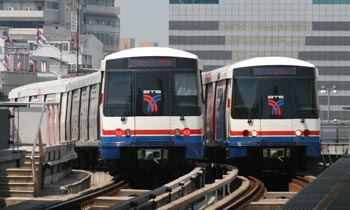
It's a journey we all have to make, and some of us on a fairly frequent basis so here are a few hints and tips about getting from the airport to the city. Taxis from the airport used to ask exorbitant fees but now any taxis joining the taxi queue at the airport must follow the airport regulations meaning they charge you the metered fare plus a 50 baht surcharge plus any expressway tolls. This will result in fares of about 300 baht to Siam Square, Sukhumvit Rd or Silom Road areas and a bit more to Khao San Road. If you don't have a lot of luggage, you can save money by using the bus, but you won't save that much – I believe the bus from the airport is now about 150 baht. If you want to take a taxi but do not want to pay the 50 baht surcharge, walk upstairs to where the taxis are dropping off departing passengers and you can save the 50 baht. Strictly speaking, taxis are not supposed to wait nor pick up from that area but if you are quick, no-one will get too bothered about it.
Minivans
Perhaps the least obvious mode of transport, at least as far as tourists or those new to the city are concerned, are the privately run minivans which run certain routes all over the city. They tend to run long main roads and usually take advantage of the expressways. Difficult to spot if you don't know what you're looking for, they have very signs with their destinations, often hand-written – and always in Thai. One seldom sees farangs using these, although they would be only too happy for you to jump on board. All around the Victory Monument area you can find these minibuses which will take you anywhere from Bangna to Laksi. The fares are cheap, usually around 20 – 25 baht and the big advantage is that they are generally much quicker than a bus would be, and cheaper than what a taxi would be. The best way to find out about them is to talk with Thais who are familiar with your local area. These really are a convenient way to travel.
Whatever mode of transport you select, getting around Bangkok will not break the bank. The buses are cheap, in fact so cheap they are almost free. Taxis are good if you want to ride in "relative comfort" and go directly from point to point – and the traffic isn't too bad. They're also good if you have a lot of shopping to carry. Motorcycles are great if you need to get somewhere in a hurry but remember, they are dangerous – and around 50 people a day die on Thailand's roads, many on motorbikes! But nothing beats the skytrain. For people living near the skytrain it is invariably their preferred way to travel.
It takes a while to work out the most efficient way to get around Bangkok but do try to do this quickly as it will save you both time and money. For instance, if you want to go from Siam Square to the Central World Plaza, a journey of not much more than 1 km, you could walk, bus, sky train, motorcycle, boat or tuktuk. Which would be the quickest? The bus! Which would be the slowest? Unless you walk at a snail's pace, probably the taxi as because of the way the streets are in that part of town, you must do a huge detour to get there by road – except for buses!